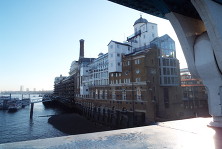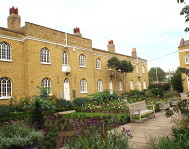








Peckham Rye Park
Peckham Rye Common, purchased as a public open space in 1868 by Camberwell Vestry, was very popular and by the 1880s suffering from overcrowding. Many houses had been built in the surrounding areas with a resulting huge growth in population. Concerns were raised about the crowded state of the Rye with the dangers from so many playing cricket and football on a confined space and plans were made to extend the space. The owners of Homestall Farm adjoining Peckham Rye to the south were prepared to sell some of their land and campaigners set about raising the money. 51 acres were bought at a total cost of £51,000 with contributions from London County Council, Camberwell Vestry and the Charity Commissioners with small donations from Lambeth, St Mary Newington and St George the Martyr Southwark Vestries.
The new park was opened by the Chairman of the London County Council on 14 May 1894 and was described in The Times on the following day:
”The ground possesses many natural attractions, and these have been as much as possible retained in the process of laying out. Great care has been taken to preserve the best of the trees and shrubs with the result that the new park is beautifully timbered. A miniature lake has been formed near the centre of the grounds, and a considerable portion of the land has been set apart for games. Twelve acres have been reserved for cricket. 10 and a half acres have been allotted to children’s playgrounds and two acres to lawn tennis. This work has been carried out by the Parks Committee of the County Council at a cost of £7,450 and has been done by the Council’s own workmen. A portion of the park, about 13 acres in extent, is occupied by Homestall Farm, but when the lease expires it is intended to acquire this additional ground also for the public use. Considerable historic interest attaches to the farm buildings, which are said to be about 200 years old, and are supposed in former times to have been used by smugglers for storing their contraband goods.”
As time went by, the park evolved. A bowling green was built and a Bowling Club established in 1910. An Old English Garden, later renamed the Sexby Garden after the first Superintendent of London County Council Parks Department, Lt-Colonel J.J. Sexby. The American Garden and the Japanese Garden were also created. It is thought the Oval was established in the 1930s, also known as the Coronation Bed as it was specially planted up with plants that formed a crown and the message “Long Live the King” to celebrate the coronation of George VI in 1937. A little later the rockery, stream and water garden were added.
By the 1980s, due to a combination of neglect and vandalism, the Park had deteriorated badly. The Friends of Peckham Rye Park was formed in 1995 to prevent any further deterioration and applied to the Heritage Lottery Fund for a grant. The bid was successful and a programme of restoration works commenced which were completed in 2005 and have transformed the park. As it says on the Friends of Peckham Rye Park website “The restored park is a joy to the community and a source of civic pride.”
Peckham Rye Park is a Victorian park adjoining Peckham Rye Common which, after a period of neglect, was restored 10 years ag0 to the beauty of its former Victorian glory. It comprises both open spaces and wooded areas, formal gardens and a community wildlife garden, and a small lake that is home to a variety of waterfowl.
The smugglers were said to have been hidden by a grand avenue of elm trees which became a part of the park. The area that had been retained by Homestall Farm was brought into the park in 1908 and the 200 year old farmhouse, described as" quaint", was demolished. More areas of land were added as other scattered buildings were also demolished.